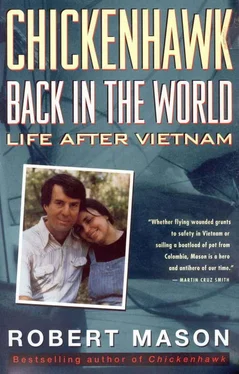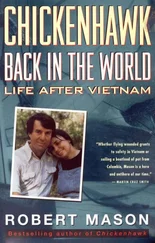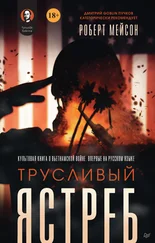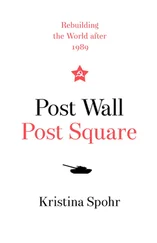Larry had just published his second book, Paco’s Story , which later won the National Book Award. He knew what he was doing. I talked to him about the trouble I was having with my robot book. He said that my strongest skill seemed to be in first-person narrative, like Chickenhawk . Maybe I should think about that.
I spent a month writing a hundred pages of a new robot book, version three. This time, the robot told the story. Clever, eh? First-person narrative. I sent this to Knox and then we drove to Maine to spend a month at my mother-in-law’s cabin on the lake. While I was there, Knox sent me back the manuscript saying, “I just don’t get this, Bob.”
I called him up and we talked. “You aren’t getting the reader involved, Bob. I kept falling asleep with this thing. You have to make people care about a machine, and I don’t think you can do it.” He paused. “Well, what are you going to do next? Get a job?”
“I don’t know. I guess I won’t write any more robot stories.”
“Good,” Knox said.
We stayed another two weeks in Maine. I concentrated on refining my sailing skills with a little Sunfish. In the evenings I sat on the porch and watched the lake, listening to waves rustling the sand, hearing loons wail. I was feeling like a freak, a one-book flash in the pan. I wasn’t really a writer, I’d just been lucky. I couldn’t think of anything else I wanted to do, and my money would run out in a year or so.
One evening a few days before we left, while I daydreamed by the lake, I saw my robot, a black plastic mannequin-looking machine, stalking silently through a jungle. Wet leaves plastered its eye covers, spider webs and jungle debris covered its body, but the robot (I had no name for it) ignored the stuff clinging to him and moved stealthily and purposely among the shadows of the jungle, stalking. The image was very exciting. My high-tech robot was contrasted against the organic lushness of the jungle, emphasizing its alien nature. I’d been telling my robot story set in laboratories where the robot just blended in with the rest of the high-tech gadgetry. The image stayed with me.
When we got back to High Springs, I decided to work on the cabin. I didn’t write a word. I spent a month installing a brick patio around the cabin. I built an upstairs deck which opened out of the eight-foot-square office Patience and I shared and made it seem larger. John and I put on a catwalk out front, a ledge to stand on to wash the bedroom windows, and built a small shed to house the washer and dryer.
The image kept returning, always the same: the robot was stalking something in a jungle and disappeared into the darkness. What was it tracking? Where was it? Who made it? Why?
When I finished my cabin improvements, a plot jumped into my head. The robot was in a rain forest in Costa Rica. The robot was being tested by the Army. (I had read about the Defense Advanced Research Projects Agency sponsoring research for such a weapon.) It was stalking a man as part of the test. That’s all I knew. I started writing.
In every version of the robot story prior to this one, I’d spent a lot of time developing a detailed outline, following it carefully, because that’s how I thought you were supposed to do it. I had only a vague idea what the plot might be for this book, and I wanted to try an experiment: I was just going to start writing and see what happened.
I worked for four months on the first 150 pages. During that time, Knox called and wanted to know what I was doing. He said, “Please don’t tell me you’re working on another robot book.”
“I’m working on another robot book.”
“Jesus, Bob. You don’t give up, do you?”
“Nope.”
“Well, send it up when you have something to show me,” Knox said, his voice reeking with pity.
I had no name for the robot until the first human character, the soldier it’d been stalking in a test, talked to it when it flunked the test by becoming more interested in a dragonfly than in killing the soldier. The soldier approached the robot and said, “Nice bug you got there, Solo.” Ah. Solo was the robot’s name. I had wondered what it might be.
I rewrote the manuscript (I was using a Macintosh, and the rewrites were fast) two times until I thought it could take Knox’s criticism. I knew it worked this time. I sent it to Knox.
A week later Knox called. His voice was filled with enthusiasm. “I don’t believe it, Bob. I actually gave a shit what happens to this thing, and I hate robots. You’ve actually done it.”
I decided to finish the book rather than try to sell it based on the first part, as I had done with Chickenhawk . Much of the story took place in a small Nicaraguan village where the robot hid from its makers. I’d never been to Nicaragua, and I wanted to know at least what it looked like. I wanted to talk to Nicaraguans to see how they talked, lived, what they ate, how they cooked, what color the sand was at Lake Nicaragua, where the story was set; I wanted to see the two mile-high volcanoes, Las Maderas and Concepcion in the lake, and a hundred other things.
I called Mr. Gamble and asked him what my chances were of getting permission to go there—a business trip, I said. He said I could try, but he knew the parole board would refuse. I didn’t want to spar with bureaucrats who make life tedious, so I spent a few months doing extensive research in the Latin American Library at the University of Florida. I read nineteenth-century explorers’ journals (in which I discovered a whole section on Nicaraguan superstitions), I read travel books, I read several histories of Nicaragua. (In my research, I discovered that the reason Nicaragua had always had so much trouble with the United States was that they happened to own the very best spot in all of Central America to build a sea-level canal. Their history is filled with broken treaties over the building of this canal on what the U.S. government still considers to be a strategic site. Nicaraguans didn’t like the idea of an American-owned canal crossing their country, and were not easily pushed around. We even sent in Marines to enforce our will. In five years of fighting, the Marines were defeated by Agusto Sandino.) I had plenty of book information, but I wanted eyewitness details. I put an ad in the paper requesting interviews with Nicaraguans. I talked to several families who told me things I couldn’t find in books. The kinds of beds peasants sleep on. Favorite country meals. I learned that Nicaraguans loved a coffee and cocoa drink, piniolio , that was so common in that country that other Central Americans called Nicaraguans Piniolios. Armed with these details, I invented a peasant village, a cooperative, and populated it with whole families. Eusebio, a teenage boy, became a major character. I modeled his mother, Modesta, on a woman, Sebastiana, we’d known in Spain. I invented life in the village, basing it on the seven months we’d spent in the village of Almonaster La Real. Everything was coming together. Solo would have a place to hide, people to talk to—people who’d use a two-billion-dollar machine to gather firewood and work on their trucks. I had a plot.
Two years after I got out of prison, I sent the completed book to Knox. I decided to call it Weapon . Knox sent it to Viking because Viking had the right of first refusal as part of my contract for Chickenhawk . Gerry Howard refused to buy it, which astounded me. Hey, I thought. Remember me? I’m a goddamn best-selling author, here. What the hell’s going on? Gerry said Viking wasn’t publishing science fiction, which was a nice way of saying he hated the book.
Knox sent it to other publishers and it was rejected. Most of the editors expressed surprise because Weapon had nothing to do with Vietnam. Mason is supposed to be a Vietnam writer, isn’t he?
Читать дальше












